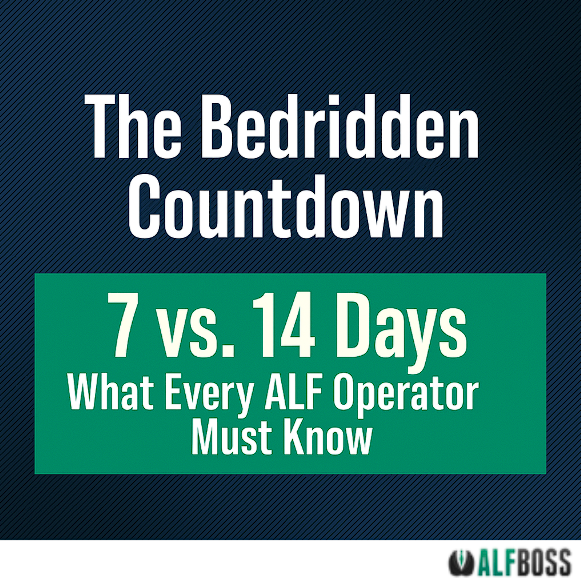
The Bedridden Countdown: 7 vs. 14 Days—What Every ALF Operator Must Know”
Few things put an ALF administrator on edge faster than hearing, “Mr. Smith hasn’t been able to get out of bed for three days.” That’s because once a resident is officially considered bedridden, the compliance clock starts ticking.
Let’s break it down by regulation:
📜 The Law: 59A-36.006 vs. 59A-36.021
- 59A-36.006 (4)(a) Continued Residency:
For facilities without an Extended Congregate Care (ECC) license, a resident may remain bedridden no more than 7 consecutive days—
❗ Unless they are on a licensed hospice program. In that case, they may remain bedridden as long as hospice services are active and appropriate. - 59A-36.021 (b)(1) ECC Licensed Facilities:
Facilities with an ECC license may keep a resident who becomes bedridden for up to 14 consecutive days.- After 14 days, if the resident is still bedridden, they must be discharged to a higher level of care unless they are enrolled in hospice.
👉 Key point: Hospice overrides the 7-day and 14-day limits. A resident already under hospice services can be bedbound and remain in the ALF if it is consistent with their care plan.
🛏️ What Does “Bedridden” Mean?
“Bedridden” = confined to bed and unable to get out without total physical assistance.
- If a resident can transfer with help → not considered bedridden.
- If they are entirely unable to get out of bed → they are bedridden, and the compliance clock starts (unless on hospice).
📝 How to Document Bedridden Status
If a resident becomes bedridden, proper documentation is the only way to protect your license:
- Day 1 – Start of Bedridden Status
- Record the exact date and time.
- Document cause (illness, fall, surgery, decline, etc.).
- Notify physician and responsible party.
- Note whether hospice is involved or referral is being made.
- Daily Documentation
- Track functional status each day.
- Document interventions (therapy, nursing visits, medications, hospice services).
- Record attempts at mobility, even if unsuccessful.
- Care Plan Update
- Revise the care plan immediately to reflect bedridden status.
- Add short-term goals (rehab, palliative care, comfort measures).
- Administrator Oversight
- Administrator/designee should personally review notes daily to track the countdown (7 or 14 days).
- Verify if hospice enrollment occurs, which changes the rule.
⏰ What To Do As the Deadline Approaches
- Day 6 (Non-ECC) / Day 13 (ECC):
- Evaluate progress with physician and care team.
- Determine if hospice referral is appropriate.
- Decide if higher level of care transfer needs to be arranged.
- If still bedridden beyond the timeframe:
- Non-ECC: Must discharge unless hospice is active.
- ECC: Must discharge to a higher level of care after 14 days—unless the resident is on hospice, in which case they can remain.
✅ Compliance Tips
- Always ask: “Is this resident on hospice?” That answer changes everything.
- Train staff to report immediately when a resident cannot get out of bed.
- Track dates carefully—use a log, spreadsheet, or EMR alerts.
- Get ahead of deadlines. Don’t wait until Day 7 or 14 to scramble.
- Document, document, document. Regulators want to see clear records of the resident’s status, physician input, and family communication.
⚠️ Bottom line:
- Non-ECC facilities: 7-day limit for bedridden residents—unless on hospice.
- ECC facilities: 14-day limit—unless on hospice.
- Hospice residents: May remain bedridden in the ALF, as long as services are active and appropriate.
With the right documentation and proactive planning, you can stay compliant and keep residents where they want to be—safe and cared for in your facility.